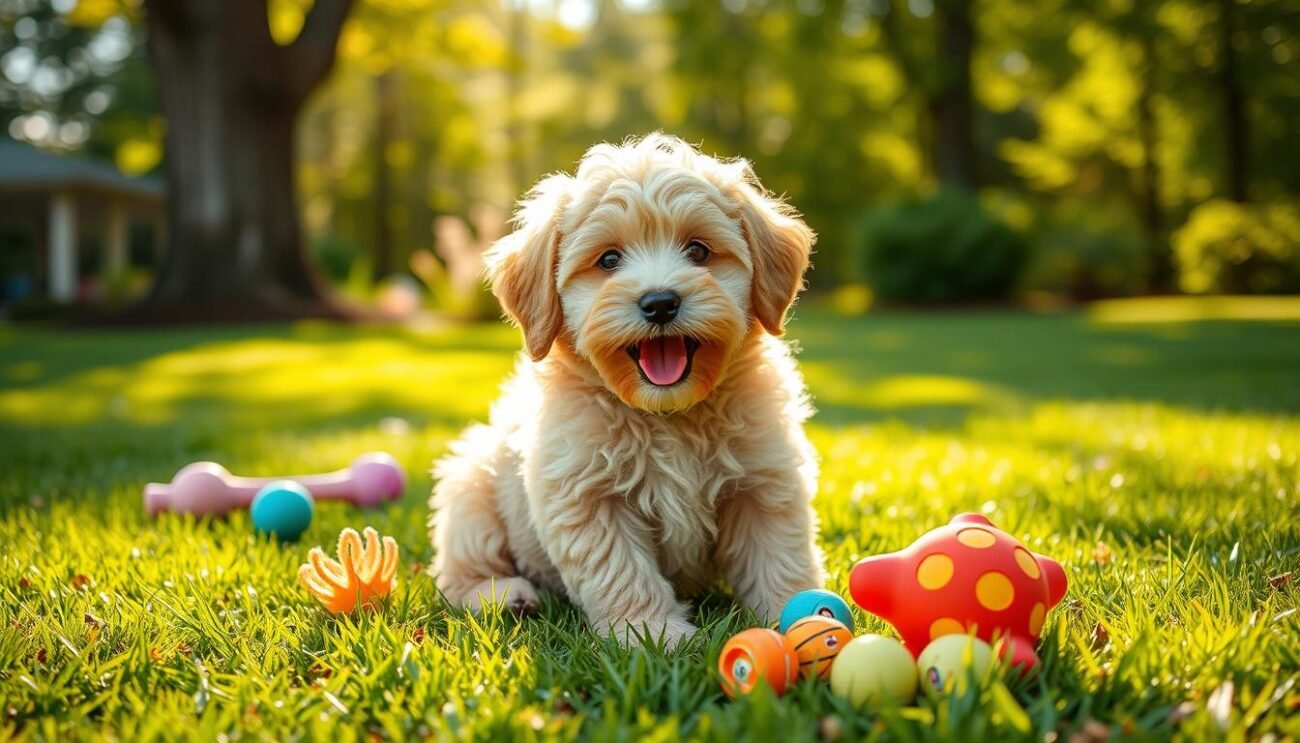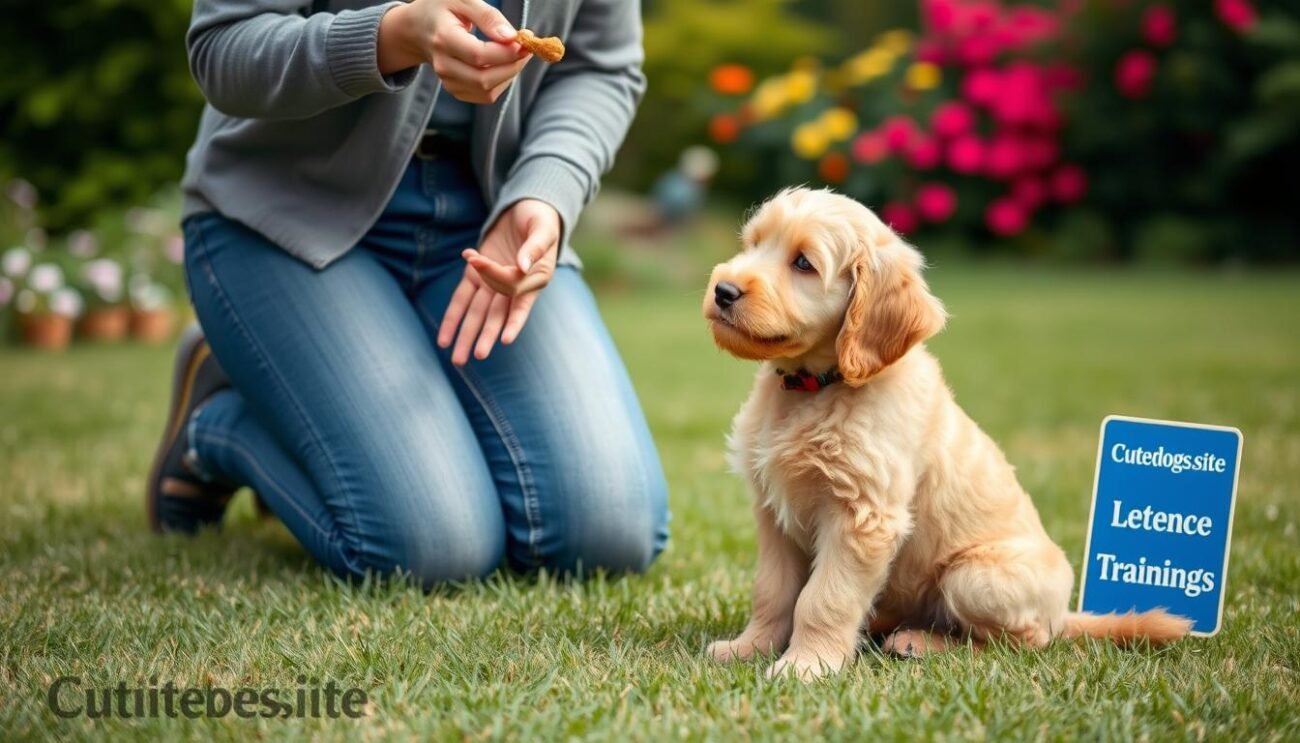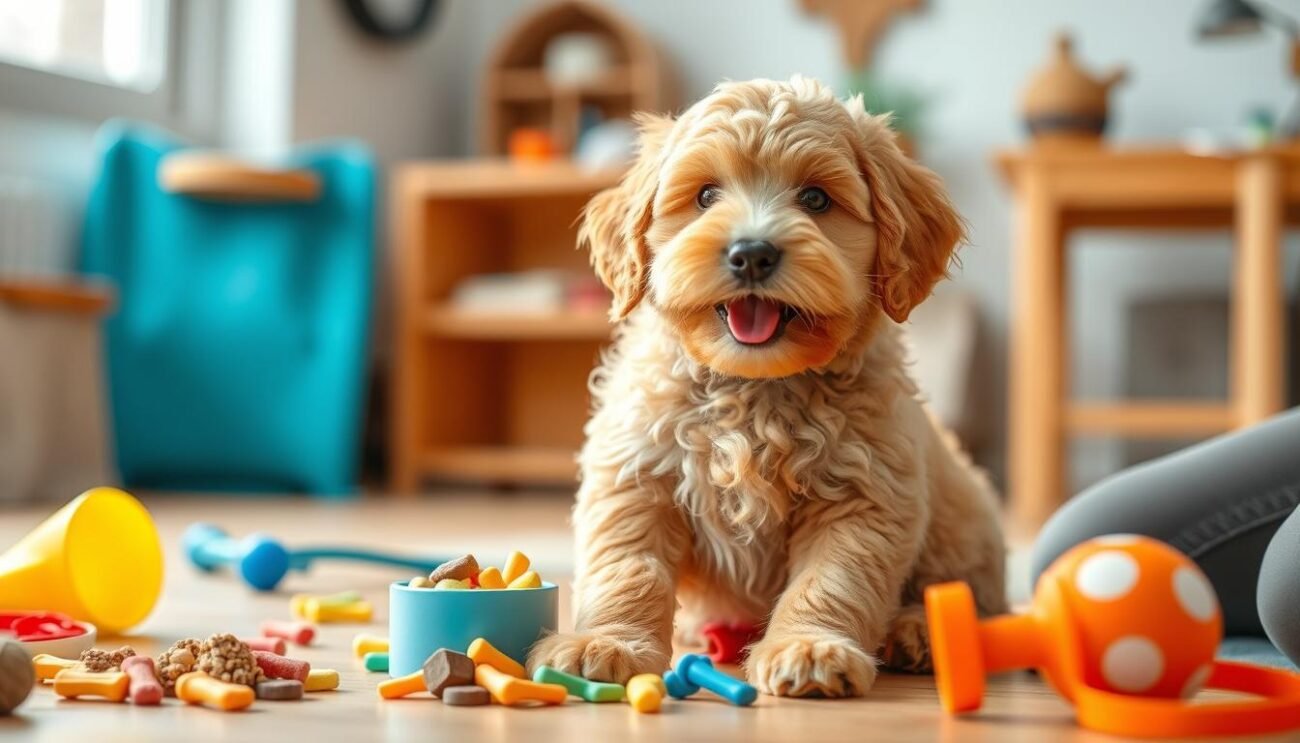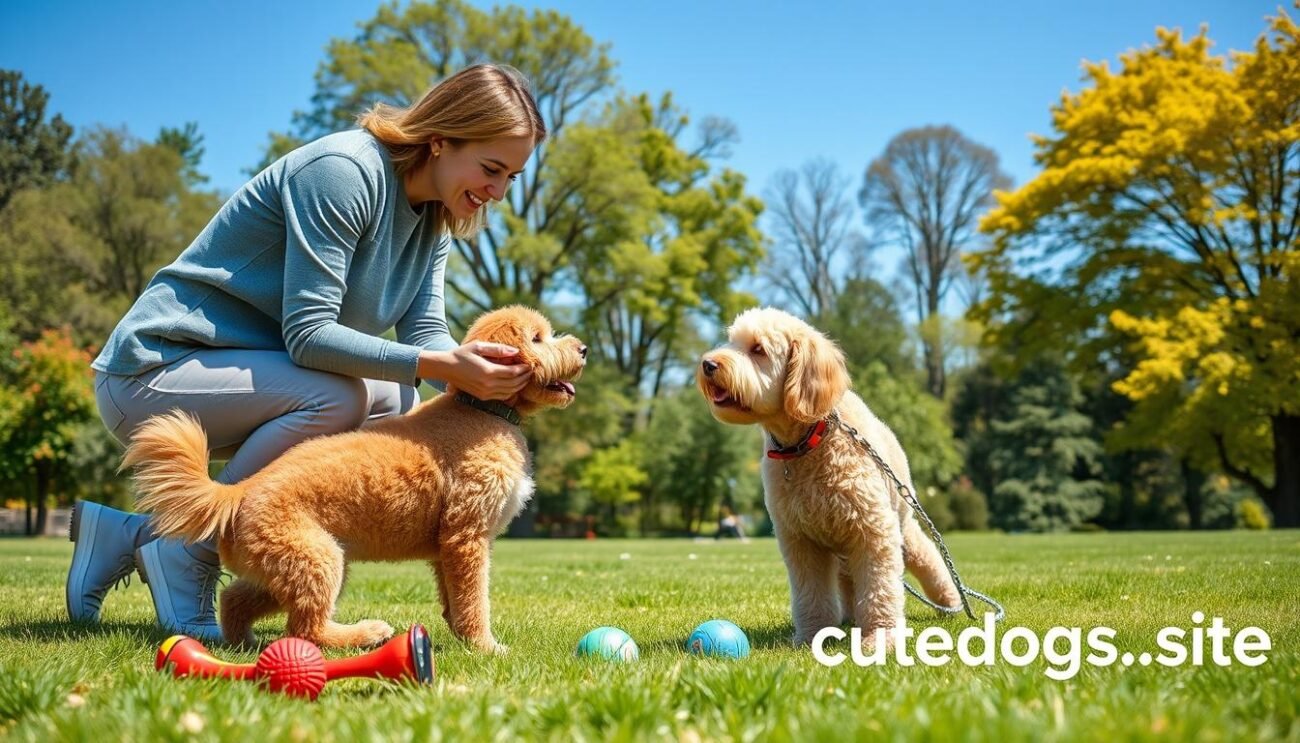Training a golden doodle with behavioral issues can be tough. But, with the right approach, patience, and consistency, you can help your furry friend become well-behaved. Whether your golden doodle bites, shows separation anxiety, or is destructive, understanding the causes and using effective training can help a lot.
In this guide, we’ll look at ways to tackle your golden doodle’s behavioral problems. We’ll cover positive reinforcement, crate training, bite inhibition, and potty training. We’ll also talk about the importance of puppy socialization, mental stimulation, and early obedience training. These are key for your doodle’s development.

Key Takeaways
- Positive reinforcement training is the most effective approach to modify your golden doodle’s behavior.
- Patience and consistency are essential when training a golden doodle puppy.
- Proper socialization and early obedience training can help prevent and address behavioral issues.
- Crate training and bite inhibition are crucial for a well-behaved and house-trained doodle.
- Providing mental stimulation through puzzle toys and interactive games can help curb destructive behavior.
Understanding Your Golden Doodle’s Behavioral Challenges
As a golden doodle owner, it’s key to know their unique traits and growth stages. These smart and loving dogs can show tough behaviors that need patience and training. Learning about puppy behavior and golden doodle behavior helps you tackle common behavioral issues in golden doodles.
Puppy Behavior and Development
Golden doodle puppies go through many stages, each with its own behaviors. From the early playful phase to the teenage years of high energy and exploration, knowing your pup’s stage helps in training.
Common Behavioral Issues in Golden Doodles
Golden doodles are usually well-behaved and love to please. But, they can sometimes show behaviors that need extra care. Some common behavioral issues in golden doodles include:
- Excessive chewing and destructive behavior
- Difficulty with potty training
- Jumping up on people
- Barking and excessive vocalization
- Separation anxiety
“If you’re thinking about a similar breed, you might want to explore the Double Doodle, another affectionate and smart breed.”
By spotting, you can help your golden doodle become a well-adjusted and well-behaved friend.
| Behavioral Challenge | Potential Causes | Recommended Solutions |
|---|---|---|
| Excessive Chewing | Teething, boredom, anxiety | Provide chew toys, increase exercise and mental stimulation |
| Potty Training Issues | Lack of routine, insufficient supervision | Establish a consistent potty schedule, use positive reinforcement |
| Jumping Up | Attention-seeking behavior, excitement | Teach the “off” command, reward calm behavior |
By grasping the unique golden doodle behavior and tackling any common behavioral issues in golden doodles, you can ensure your pup’s success. This way, you’ll enjoy a happy and harmonious bond with your furry companion.
Establishing a Positive Reinforcement Training Approach
Training your golden doodle should be positive. This method is better than punishment. It makes learning fun and stress-free.
Clicker training is a great way to do this. It uses a device that makes a “click” sound. This marks the moment your dog does something right. Then, you give them a treat to reward them.
| Positive Reinforcement Training | Traditional Training |
|---|---|
| Focuses on rewarding good behavior | Often relies on punishment or correction |
| Creates a positive, stress-free learning environment | Can be stressful and demotivating for the dog |
| Builds a strong bond and trust between dog and owner | May damage the dog-owner relationship |
| Helps the dog learn new behaviors quickly and enthusiastically | Slower learning process and potential for confusion |
Using positive reinforcement, your golden doodle will want to please you. They’ll learn new things with excitement. This method strengthens your bond, leading to a lifetime of joy together.

“The key to training a golden doodle is to make it a positive experience, not a negative one. Reward-based training is the way to go.”
Mastering Patience and Consistency in Training
Training your golden doodle needs patience and consistency. These qualities help build a strong bond with your dog. They are key to reaching your training goals.
The Importance of Patience
Patience is vital when training your golden doodle. These smart and lively dogs can be tough, but patience helps. Patience in training lets you focus on good behaviors and correct bad ones.
It also lets you celebrate small wins. This approach makes training more rewarding for both you and your dog.
Consistent Training Techniques
Consistency in training is also crucial. By establishing a training routine, you give your dog a stable environment. This helps them learn faster and remember better.
Patience and consistency work together. Training calmly and steadily sets your dog up for success. With these, you’ll train with confidence and see great results.
Puppy Socialization: A Key to Well-Behaved Dogs
Proper puppy socialization is key for a well-adjusted golden doodle. It helps them grow into confident, well-behaved companions. By exposing them to various people, animals, and places early on, they learn to adapt and feel comfortable in different situations.
Socializing golden doodle puppies starts early, between 3 and 12 weeks. This is when they are most open to new experiences. It shapes their future behavior and personality.
- Introduce your puppy to a diverse array of people, including adults, children, and individuals with different appearances and personalities.
- Expose your puppy to various environments, such as parks, pet-friendly stores, and different types of transportation, to help them become comfortable in a wide range of settings.
- Socialize your puppy with other well-behaved dogs to help them learn appropriate play and social skills.
Early socialization must be positive and controlled. This ensures your puppy feels safe and comfortable. With patience and consistency, your golden doodle will be confident, adaptable, and well-behaved for life.
| Benefits of Puppy Socialization | Potential Consequences of Lack of Socialization |
|---|---|
| Increased confidence and adaptability Reduced risk of fear-based or aggressive behaviors Improved ability to interact with people and other animals Stronger bond with their owner | Fear, anxiety, and aggression towards people or animals Difficulty adjusting to new environments or situations Increased likelihood of behavioral problems Strained relationship with their owner |

Investing time and effort into socializing your golden doodle puppy is an investment in their future well-being and your shared enjoyment.
Crate Training: A Valuable Tool for Golden Doodle Owners
Crate training is great for golden doodle owners. It helps with housetraining and gives your dog a cozy spot. Learning crate training can solve many behavioral issues and keep your dog happy.
Benefits of Crate Training
Crate training has many benefits. It helps with potty training and stops your dog from getting into trouble. It also makes your dog feel safe and comfortable. Plus, it’s useful when you travel or leave your dog alone.
Proper Crate Training Techniques
To crate train well, start by making it a positive experience. Give your dog treats, toys, and comfy bedding. This makes the crate a safe place, not a punishment.
Be consistent and patient. With the right approach, crate training will make your dog well-behaved and happy.
“Crate training is an essential part of raising a well-behaved golden doodle. It provides a safe and secure space for your pup, while also helping with housetraining and preventing destructive behaviors.”
Bite Inhibition: Teaching Your Puppy Gentle Mouth Manners
As a golden doodle owner, teaching your puppy bite inhibition is key. Puppy biting can become a problem if not handled right. With bite inhibition training, you can stop this behavior and teach your puppy to play gently.
Teaching bite inhibition means showing your puppy how to play without being too rough. By encouraging gentle play and stopping any rough behavior, your golden doodle will learn to play nicely. This makes playtime better for everyone.
- Start early and be consistent. Bite inhibition training should begin as soon as your puppy comes home, as this is a critical time for developing appropriate mouth manners.
- Use positive reinforcement. Reward your puppy when they exhibit gentle mouthing or respond to your commands to “be gentle” or “no biting.”
- Redirect their biting impulse. When your puppy starts to bite, quickly substitute a chew toy or other appropriate object to redirect their attention and satisfy their need to chew.
- Avoid harsh punishment. Yelling, hitting, or other punitive measures can backfire and make your puppy more likely to bite out of fear or frustration.
With patience, consistency, and positive reinforcement, you can teach your golden doodle bite inhibition. They will become a well-behaved, gentle friend.
“The key to teaching bite inhibition is to be patient and consistent. With time and the right training approach, your golden doodle will learn to control their bite and interact with the world in a more gentle and appropriate way.”

Potty Training Your Golden Doodle: Tips and Tricks
Potty training a golden doodle can be tough but rewarding. Consistency and patience are key. Follow these tips to make potty training easier with your furry friend.
Establish a Routine
Consistency is key in potty training. Set a regular schedule for potty breaks. Take your puppy out in the morning, after meals, after play, and before bed. This routine helps your pup learn when and where to go.
Use Positive Reinforcement
Reward-based training works best for golden doodles. Praise and reward your puppy when they go in the right spot. Treats and affection help reinforce good behavior.
Manage Accidents
Accidents are part of potty training. Stay calm and don’t punish your puppy. Clean up the mess quickly and take your pup outside. This teaches them the right spot.
With patience and consistency, you can potty train your golden doodle. Enjoy a well-behaved, housebroken companion.

“Potty training a puppy is a dance of patience and positive reinforcement. With the right techniques, you can turn your golden doodle into a house-trained star.”
Providing Mental Stimulation for Your Active Doodle
Golden doodles are full of energy and smart. They need lots of mental play to avoid boredom and bad behavior. Puzzle toys, games, and training help them use their energy in good ways.
Puzzle Toys and Interactive Games
Puzzle toys and games are great for your golden doodle’s brain. Get puzzle toys that make them work for treats. Games like hide-and-seek also keep their mind sharp and strengthen your bond.
Mental Exercise Through Training
Training is key for your golden doodle’s happiness. Teach them new tricks and commands. Use obedience training, agility, or scent work to keep their mind busy.
By focusing on mental play, you prevent boredom and improve their learning. Puzzle toys, games, and training keep their mind active and happy.

“A well-exercised mind is just as important as a well-exercised body for a golden doodle’s overall happiness and well-being.”
Early Obedience Training: Building a Foundation
Starting early is crucial when training your golden doodle. Early obedience training sets the stage for a well-behaved pet. By teaching basic commands early, you create lasting good habits.
Puppy obedience training does more than teach simple commands. It builds a strong bond and trust. It also establishes you as the leader. With positive reinforcement, your golden doodle will learn to be well-mannered and adaptable.
- Teach basic commands such as “sit,” “stay,” and “come” to lay the foundation for more advanced training.
- Use positive reinforcement, like treats and praise, to encourage desired behaviors and make training a positive experience for your puppy.
- Be patient and consistent in your approach, as it may take time for your golden doodle to master these new skills.
Early obedience training is an investment in your golden doodle’s future. It ensures they grow into a well-behaved and adaptable companion. They’ll navigate the world with confidence and grace.

being forceful with training doodle puppy
Training your golden doodle puppy needs care and kindness. Forceful methods might seem quick, but they harm more than help. Use positive reinforcement to teach your pup and grow your bond.
Positive reinforcement rewards good behavior, making your pup want to do it again. It builds trust and a strong relationship. Forceful training, on the other hand, can cause fear and stress, hurting your pup’s feelings and well-being.
- Avoid harsh reprimands, physical punishment, or intimidation tactics.
- Instead, use positive reinforcement, such as treats, praise, and favorite toys, to reward good behaviors.
- Be patient and consistent in your training, as it takes time for your golden doodle to learn and respond to positive reinforcement.
Choosing positive reinforcement for your golden doodle puppy makes them a well-behaved friend. It also creates a lifelong bond of trust. Your pup’s success shows your dedication to their happiness and your gentle guidance.
“Positive reinforcement is the key to building a strong, trusting relationship with your golden doodle. It’s a win-win for both of you.”

By using positive reinforcement and avoiding force, you’ll raise a happy, confident golden doodle. With patience, consistency, and care for your pup, you’ll build a lifelong partnership of trust and understanding.
Housebreaking Your Golden Doodle: Strategies for Success
Housebreaking a golden doodle puppy can be tough but rewarding. Success comes from setting consistent routines, watching them closely, and using positive reinforcement. These strategies help you potty train your dog and reduce accidents at home.
Consistency and Supervision
Being consistent is key to housebreaking. Create a schedule for taking your golden doodle outside, like in the morning, after meals, and before bed. Watch your puppy closely for signs they need to go, like sniffing or circling. Quick action helps them go to the right spot.
Positive Reinforcement for Potty Training
Positive reinforcement is great for potty training golden doodles. Praise and reward your puppy when they go in the right spot. This makes them want to do it again. Don’t scold them for accidents, as it can hurt your bond and the training.
Housebreaking a golden doodle needs patience, consistency, and positive reinforcement. Stick to these tips to housebreak golden doodle puppies and have a well-behaved pet.

| Housebreaking Technique | Description | Benefits |
|---|---|---|
| Consistent Scheduling | Establish a regular routine for taking your golden doodle outside, such as before meals, after playtime, and before bedtime. | Helps your puppy learn when and where to eliminate, reducing accidents. |
| Close Supervision | Closely monitor your golden doodle’s behaviors and body language to identify the need to go potty. | Allows you to promptly take your puppy outside, reinforcing the appropriate elimination location. |
| Positive Reinforcement | Reward your golden doodle with praise, treats, or toys when they successfully eliminate in the designated area. | Encourages the desired behavior and creates a positive association with potty training. |
Curbing Destructive Behavior in Golden Doodles
As a golden doodle owner, you might face the challenge of destructive behavior. Issues like constant chewing and separation anxiety can be tough. But, with the right steps, you can stop these behaviors and have a happy, well-behaved pet.
Addressing Chewing Habits
Chewing is normal for puppies, but it can become a problem. To stop your golden doodle from chewing on everything, give them lots of toys and chews. Change these items often to keep them interested. Also, watch your dog during play and guide them to chew on the right things.
Managing Separation Anxiety
Golden doodles love people and can get anxious when alone. To help, start by leaving them alone for short times and then longer. Give them puzzle toys and Kongs filled with treats to keep them busy and happy.
Stopping destructive behavior in golden doodles takes time, patience, and a few strategies. By tackling chewing and separation anxiety, you can have a pet that loves and respects your home.

“The key to managing destructive behavior in golden doodles is to provide them with the right outlets for their energy and natural tendencies.”
Establishing Leadership and Setting Boundaries
Being the leader is key for a well-behaved golden doodle. Clear boundaries and expectations help train your pet and stop bad habits.
Consistent training is a big part of being a leader. Training your golden doodle with treats or praise shows them what’s right. This strengthens your bond and makes them listen to you.
- Consistently reinforce commands and desired behaviors
- Avoid rewarding undesirable behaviors, even inadvertently
- Be patient and persistent in your training approach
Setting boundaries is also vital. This means rules for home areas, furniture, and what’s okay to do. Sticking to these rules shows your dog who’s boss.
| Boundary | Example |
|---|---|
| Areas of the home | Restricting access to certain rooms or furniture |
| Acceptable behaviors | Not allowing jumping on people, chewing on furniture, or excessive barking |
| Obedience commands | Requiring your golden doodle to sit, stay, or come when called |
By establishing leadership and setting boundaries, you’ll have a happy and well-behaved golden doodle. With patience, consistency, and positive training, they’ll be your loyal friend.

Conclusion
Training a golden doodle puppy needs patience, consistency, and positive reinforcement. Knowing your pup’s challenges and needs helps build a strong training base. This is key for their socialization and behavior.
The main points from this guide are:
- Use positive reinforcement to train, rewarding good behavior instead of punishing bad ones.
- Focus on socializing your puppy to make them confident and well-adjusted in different places.
- Crate training is great for housebreaking and giving your pup a safe space.
- Deal with common issues like biting and destructive behavior through consistent training and keeping them busy.
- Stay patient and consistent, as golden doodles can be smart but also stubborn at times.
By using these strategies, you’re on the path to raising a well-behaved, social, and obedient golden doodle. Training is a journey, and with effort and dedication, you can overcome any challenges. This will lead to a rewarding relationship with your dog.
| Key Takeaways | Benefits |
|---|---|
| Positive reinforcement training | Encourages desired behaviors, builds trust and cooperation |
| Puppy socialization | Helps pup become well-adjusted and confident |
| Crate training | Supports housebreaking and provides a sense of security |
| Addressing behavioral issues | Prevents and resolves undesirable behaviors |
| Patience and consistency | Crucial for successful training of golden doodles |
Training your golden doodle is a rewarding journey with its ups and downs. By using these strategies, you’ll be on your way to a well-behaved, happy, and loving companion.

“The key to training a golden doodle is to approach it with patience, consistency, and a focus on positive reinforcement. With the right techniques and mindset, you can unlock the full potential of your furry friend.”
Additional Resources
If you want to learn more about training your golden doodle, there are many resources out there. You can find books, online forums, and more. These can give you great tips and help you and your dog do well together.
For a deep dive into golden doodle behavior and training, check out “The Art of Raising a Puppy” by the Monks of New Skete and “The Perfect Puppy” by Gwen Bailey. These books are full of advice on socialization and obedience training. They help you understand the special needs of a golden doodle.
Online, you’ll find a community of golden doodle lovers. Sites like the Golden Doodle Association of North America (GDANA) and forums like /r/goldendoodle on Reddit are great places to connect. You can ask questions, share tips, and learn from others who own doodles.
FAQ
What are the key principles for effectively training a golden doodle puppy?
To train a golden doodle puppy well, use positive reinforcement. Be patient and consistent. Also, provide proper socialization and show leadership.
How important is positive reinforcement when training a golden doodle?
Positive reinforcement is very important for golden doodle puppies. It builds a strong bond and encourages good behavior without punishment.
Why is puppy socialization so crucial for golden doodles?
Socialization is vital for golden doodle puppies. It helps them become confident and well-behaved. Early exposure to new things helps them adapt better.
What are the benefits of crate training a golden doodle?
Crate training is beneficial for golden doodle owners. It provides a safe space, helps with housebreaking, and prevents destructive behavior when unsupervised.
How can I teach my golden doodle puppy bite inhibition?
Teach bite inhibition by interrupting biting and redirecting to chew toys. Praise and reward gentle mouth manners. This helps control their bite force.
What are some tips for successfully potty training a golden doodle?
For successful potty training, have a consistent routine and supervise closely. Use positive reinforcement for correct behavior. Manage accidents calmly and patiently.
How can I provide mental stimulation for my active golden doodle?
Provide mental stimulation with puzzle toys, games, and training. This prevents boredom and channels their energy positively.
When should I start obedience training with my golden doodle puppy?
Start obedience training early to build a strong foundation. Begin as soon as you bring your puppy home.
How do I avoid being too forceful when training my golden doodle?
Use positive reinforcement like treats and praise instead of force. Be patient and consistent, as golden doodles respond well to gentle methods.
How can I effectively curb destructive behavior in my golden doodle?
To stop destructive behavior, provide exercise and mental stimulation. Set clear boundaries and use positive reinforcement to redirect their energy.






